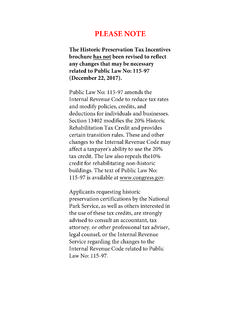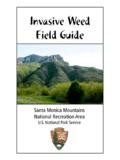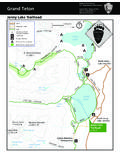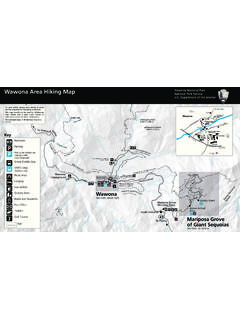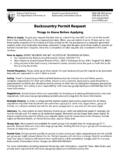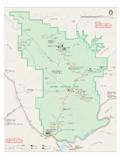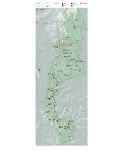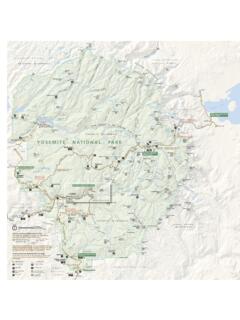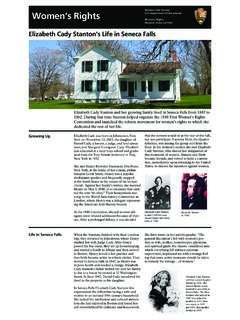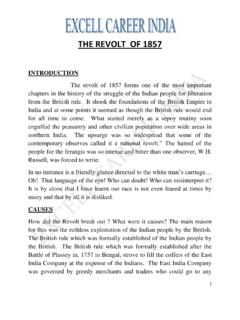Transcription of The War for American Independence - National Park Service
1 the war for American Independence The lengthy war had been costly and the British Parliament looked to taxation to pay the war debts. The colonists rebelled. INTRODUCTION At the conclusion of the French and Indian War, the first Treaty of Paris (1763) defined the British territory in North America. The territory was limited to the area east of the Appalachian Mountains. The western watershed and the lands beyond were reserved for the Indians. The British Army was charged with the protection of the colonies. The lengthy war had been costly and the British Parliament looked to taxation to pay the war debts. Various attempts were made to tax the Americans and the colonists rebelled. Their argument was that they were being taxed by a parliament where they had no representatives. The colonists harassed tax collectors and, in Boston, demonstrated against the British crown. Shots were fired and five civilians were killed (1770). The situation deteriorated from that point.
2 The first shots of the American Revolution were fired at Lexington, Massachusetts, on April 19, 1775. Although much of the fighting in the early years occurred in the north, there were important incidents that occurred in the Carolinas: 1. November 19-21, 1775, at Ninety-Six, South Carolina. Local Tories besieged Savage s Old Fort near Ninety-Six which was held by local Patriot forces. The encounter ended in a truce. 2. February 27, 1776, at Moore s Creek Bridge, North Carolina. Loyalist Highland Scots attacked patriot militia units. The Scots were defeated with heavy casualties insuring that British loyalists would not control the Carolinas. 3. June 28, 1776, at Sullivan s Island, South Carolina. The British attempt to take Charleston was thwarted when the cannonballs fired from ships of the British Navy failed to penetrate the palmetto log fortifications on Sullivan s Island. The palmetto tree became South Carolina s tree and is depicted on that state s flag.
3 The Commander of the Continental Army, General George Washington, had the task of raising and training a new army. He attempted to avoid confrontation, when possible, in the early months in an attempt to gain time. the war moved across New England and into Canada. Finally, at the Battle of Saratoga, (New York), an engagement which lasted from September 19 to October 17, 1777, the British surrendered Gen. Burgoyne s army. Seeing that the war in the northern colonies was not winnable without a massive infusion of new troops, the British Parliament sought ways to bring the war to a conclusion. The taxes had been increased tenfold in England to pay for a long war that they had thought to win within a few months. Now, years were passing with no solution, casualties were mounting and the British taxpayers were paying for 30,000 Hessian soldiers, German mercenaries who were paid to fight for England. Parliament endeavored to move the war to the southern colonies where they believed the territory could be won by British regular troops and then held by Loyalists (Tories).
4 By moving British troops from the north to the south, and utilizing the large number of Carolina Tories, they believed they could sweep up through the Carolinas to Virginia. This strategy is known as the Southern Campaign of the Revolutionary War. Material Culture: the Fife and Drum ROBERT HOOPER FOR NPS GOAL: To introduce to students material culture and music related battle. BACKGROUND INFORMATION Music played an important part in the Revolutionary army. Each company was led by a fife and drum. Each company, in turn, was expected to have at least one drummer and one fifer. A regiment might include as many as 20 of each, and include a fife major and drum major. The music boosted camp morale, assisted in marching cadence and contributed to the pomp of ceremonies. Faster music produced a faster marching cadence. Such music was based on British models and techniques. British cadence of the era called for 60 beats for the ordinary step and 120 for the quickstep.
5 The drum was especially important since it served as a means of signaling and conveying orders more effectively, being heard better than the human voice above the din of battle. Drums could signal an army to take such actions as to strike tents and prepare to march, troop to the regimental colors (flags or banners), march (move out), arise at daybreak, return to tents at night until reveille the next morning, take up weapons, and have a conference with the enemy. Many drummers were young boys, often as young as 16. Drums and fifes were made from various natural and available materials. Drums were often made of wood, with animal skins stretched by ropes to provide a drum head. Sticks were wooden. Most fifes were crude wooden instruments, often made of boxwood. Some iron fifes were found. Trumpets were often used by cavalry and bugle horns by light infantry. Riflemen often used their own innovations. The band movement in America most likely has its origins in the military music of early colonial America.
6 High school and other bands in uniform remind us of this military tradition. PRE-SITE ACTIVITIES 1. Have students learn standard Revolutionary Era drum or fife music for: General Strike tents and prepare to march Assembly Trotting to the colors March The troops move out Reveille Soldiers rise at daybreak Tattoo Soldiers return to the tents and remain until reveille next morning Alarm Alarm to take arms Parley When a conference with the enemy is desired Indicate meal time Indicate religious services (Source: Camus, Raoul F. Military Music of the American Revolution.) 2. Have other students interpret and carry out drum commands, then reverse the role of the participants. (See below.) 3. Or, have students meet in a group to make up their own signals and attempt to interpret those signals as described above. 4. Have students learn simple Revolutionary War era songs, and either sing them or play them on a fife or drum. Or, play recordings of such songs and discuss the meaning of the words.
7 5. Discuss what materials would have been used to make fifes and drums. How readily available were these materials? What alternative materials could be used? How would certain materials affect the quality and volume of sound? What alterations or materials would create a more bass sound? 6. Discuss alternative ways of communicating with troops. Contrast the bugle (used more in later wars) to the drum as a means of signaling. 7. Define words and terms such as (1) parley, (2) reveille, (3) strike tents , (4) colors (regimental banners), (5) camp morale , (6) cadence, (7) company, and (8) regiment. Have students compose sentences using these words or terms or, in addition, have them write a fife and drum story using the same. 1. parley an informal conference between enemies under a truce 2. reveille a signal to awake military troops and alert them to assignments 3. strike tents to take down tents 4. colors regimental flag 5.
8 Camp morale emotional or physical conditions of troops in the face of hardships 6. cadence the rhythmic flow of a sequence of sound 7. company a relatively small group of soldiers 8. regiment a unit of ground forces consisting of two or more battalions SOME DRUM SIGNALS Face right! Single stroke, and flam* Face left! Two single strokes, and flam Face right and turn about! Three single strokes, and flam Halt! Flam. Fix bayonets, marching! Roll**, and flam Return Bayonets, marching! Two ruffles**, and flam * a drumbeat consisting of two notes in quick succession, with accent on the second ** the continuous sound of a drum rapidly beaten ** a low continuous beating of a drum ON-SITE ACTIVITIES 1. Watch the program, Ninety Six: A Crossroads of a Revolution. Watch and listen for the use of fifes and drums. Listen to the music playing in the Visitor Center too. 2. Use a drum to take onto the battlefield. Have students give drum signals as suggested in PRE-SITE ACTIVITIES.
9 3. See how far away such signals can be heard. Appoint a drum major to direct use of the drum. POST-SITE ACTIVITIES 1. Have students research the use of drums in history in general and the Revolutionary War in particular. 2. Have students research use of fifes in history in general and the Revolutionary War in particular. 3. Show students pictures of artwork on drums. Have students design art for drums which depict Revolutionary War motifs/themes or those of their own design. 4. Have students complete a bibliography of American literature in which drum or drums are included in the title. OBJECTIVE/PROCESS STANDARDS The student will able to list the musical functions of fife and drum in relationship to Revolutionary armies and battles. The student will explain why certain materials were used for construction of fife and drum. The student will recount orally or in writing the relationships between the historic origins of fife and drum and use in the Revolutionary War era.
10 The student will compare and contrast such instruments to later use of bugles and other instruments. The student will describe elements of music and sound. The student will design artwork for drums. STRANDS: Social Studies, Music, Science, Language Arts, Visual Arts STATE OBJECTIVES/STANDARDS: North Carolina: Social Studies, Grade 4, Goals , , ; Grade 8, Goal Music: Grades 3-5, Goals , , , , , , , , , , , ; Grades 6-8, Goals , , , , , , , , , , , , , Science: Grade 5, Goals , ; Grade 6, Goals , Language Arts: Grade 3, Goals , , ; Grade 4, Goals , , ; Grade 5, Goals , , ; Grade 6, Goals ; Grade 7, Goals , , ; Grade 8, Goals , Visual Arts: Grades 3-5, Goals , , , , , , , , ; Grades 6-8, Goals ; , ; , , , , , South Carolina: Science - Grade 4 - I-A; IV-A Language Arts - Grade 3 - III-B; V-A, B; Grade 4 -II- A; III-A, C, E, G; IV-A, B, E, H; V-A, B; Grade 5 -II- A, III-A, B, IV-A, E, I; V-A; Grade 6 - II-A, B; III-E, G, H; IV-A, B, K; V-A; Grade 7 - II-A; III-A, B; IV-A, C, F, J; V-A; Grade 8 - II-A, B, C; III-B, E, G; IV-A, B, E.
